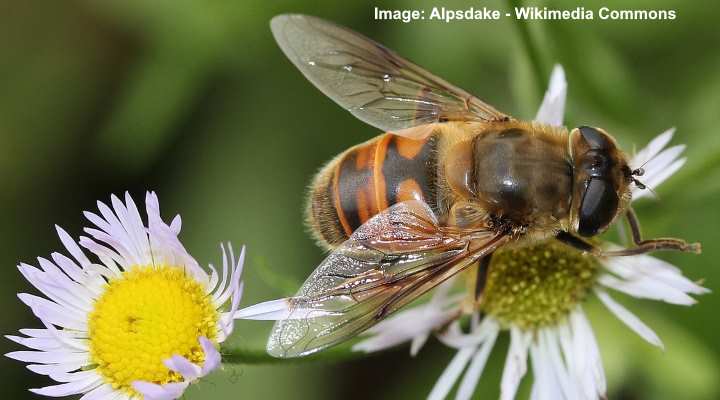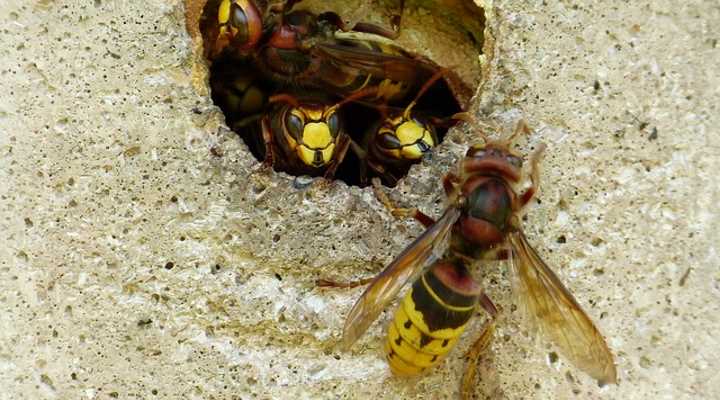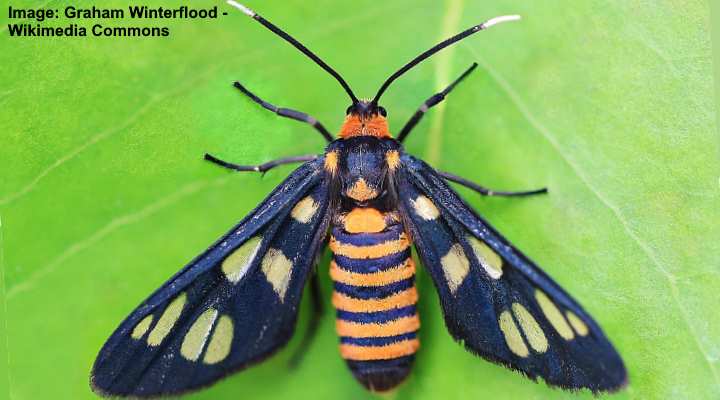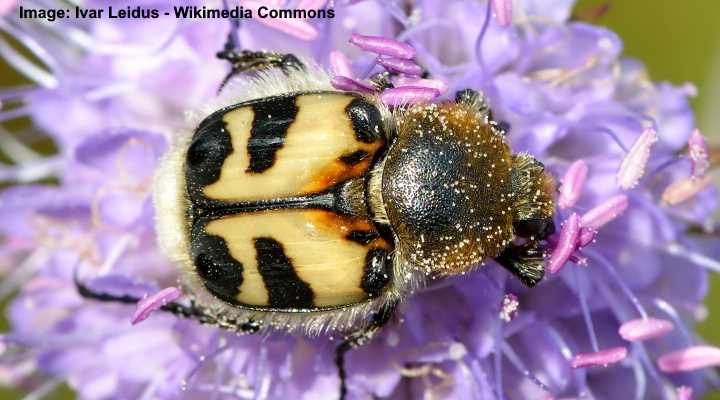Insects That Look Like Bees (Flies, Wasps, Bugs) with Pictures and Identification

Many insects mimic bees in their appearance, behavior, flying action, and size. Wasps are the most obvious bee mimics because of their black and yellow striped bodies and ability to cause a painful sting. However, some black and yellow flies, moths, beetles, and ants look remarkably like bees. Apart from wasps and hornets, many of the bugs that look like bees are relatively harmless. So, being able to identify insects that look like bees can help to spot harmless bugs from stinging ones.
In many cases, it’s easy to spot bee lookalikes by examining the body, antennae, and behavior. For example, bees have an identifiable furry body that is relatively stout. However, bee mimics such as wasps, hoverflies, bee flies, and beetles tend to have smooth bodies. In addition, while insects that resemble bees are generally pollinators, some flying insects, especially wasps, are more aggressive insects than bees.

A honey bee (in the picture) is characterized by its furry body, 2 pairs of wings and long antenna
This article is a guide to identifying various bug-like insects that look like bees. Descriptions and pictures of bee mimics will help to spot harmless flies, beetles, and ants from stinging bees. You will also learn how to tell the difference between bees and wasps.
What Are Bee Mimics?
Bee mimics are bugs, flies, wasps, and other insects that are easy to mistake for bees. The bee-like insects usually have a dark body with yellow stripes—characteristics of honeybees and other bee species. In addition, some bee lookalikes have stingers, either real ones like wasps have, or imitation ones.
Bee mimics use their behavior and appearance to ward off predators. Some insects resembling bees have fuzzy hairs, make buzzing sounds, and have a similar body form. For example, one type of bee-like fly has a long protruding tongue that looks like an extended stinger.
What Insects Look Like Bees?
Wasps are the most common flying insects that are mistaken for bees. However, their slender, smooth bodies soon give them away as not being bees. Hoverflies are the bugs that most resemble honeybees. The solitary insects are hairy and look and act just like you’d expect a typical bee to behave.
The yellow-jacket moth, bee-fly, European hornet, bee beetle, and the four-spotted velvet ant are other common bee-like insects.
Flies that Look Like Bees (With Pictures)
It is easy to mistake certain species of hoverflies, drone flies, and bee-flies for bees. Here are some descriptions of bee mimics that are species of flies.
Hoverfly (Syrphidae)

There are different species of hoverflies with various body patterns that look like bees
Hoverflies are the type of insect that most commonly resembles a typical bee. Many hoverfly species have bands of yellow and black colors, making them hard to tell apart from a bee. Also, hoverflies hover around flowers, feeding on nectar, just as you’d expect a honeybee to do.
Pictures of hoverflies show that they generally have a smoother body than a typical bumblebee or honeybee. Another way to tell a hoverfly apart from a regular bee is the number of wings. Flies have one pair of wings, whereas bees and wasps have two pairs.
There are another few tell-tale signs to help identify honeybees from hoverflies. Flies have larger compound eyes than bees. In addition, bee-like flies have short stumpy antennae. Finally, although some hoverflies have fuzzy bodies, most of them are smooth, making them look more like wasps than bees.
Oblique Streaktail (Allograpta obliqua)

Oblique streaktail (Allograpta obliqua) is a type of hoverfly that resemble a bee
With its yellow body and black stripes, it could be easy to mistake the oblique streaktail for a small bee. However, the oblique streaktail is a type of hoverfly with a bright yellow and black body. In addition, it has two sizeable reddish compound eyes, a pair of wings, and short antennae.
Hoverflies such as the oblique streaktail are beneficial insects for your garden. Attracting these flies to your garden can help to reduce populations of pests like aphids and other soft-bodied insects. The bee lookalikes lay larvae near aphids and start feeding on aphids when they hatch.
Related reading: How to get rid of aphids naturally.
Common Drone Flies (Eristalis tenax)

The common drone fly (Eristalis tenax) is similar to honey bee but is entirely harmless
The common drone fly looks like a small honeybee due to its fuzzy body, brown and yellow-orange markings, and habit of feeding on flower nectar. This bee mimic hovers near brightly-colored flowers. The adult is about 1” (2.5 cm) long, making it similar in size to a honeybee drone.
Looking at pictures of honeybees and drone flies, it can be difficult to tell the species apart. Both have dark brown coloring. However, the common drone fly has one pair of wings, not two, and larger compound eyes. Also, unlike honeybees that can sting, drone flies are entirely harmless.
Bee-fly (Bombylius)

The large bee-fly (Bombylius major) mimics the habits of bees and has long protruding tongue
The bee fly looks remarkably like bumblebees and bees. The fly gets its name “bee-fly” because it mimics the habits of regular bees. The furry flying insects can have colors ranging from orange to yellow. They are also known to infest solitary bee nests, destroying the bee larvae.
The way to distinguish between a bee-fly and a regular bee is by its long protruding tongue (proboscis). Bee-flies use this to feed on nectar as they hover at flowers like a hummingbird. Additionally, most bee-flies don’t have the distinctive striped markings that bees are known for.
Wasps that Look Like Bees (With Pictures)
Many wasp species may look like bees and have similar behavior, but you can generally tell wasps apart from bees. Unlike bees, wasps have a slender, smooth body with a visibly narrow waist, unlike a bee’s stout body. Also, wasps can be more aggressive than bees.
Let’s look in detail at some of the common species of wasps that bear the closest resemblance to bees.
Yellowjacket or Yellow Jacket (Vespula)

A close up picture of Vespula germanica (European wasp, German wasp, or German yellowjacket) that is well established in the Northern Hemisphere
Yellowjackets are wasps that are mistaken for bees due to their size and black and yellow stripes. In some places, the yellow wasps have the common name “meat bees.” But close-up pictures show the difference between the yellowjackets and bees—the lack of a furry body common to all bees.
Other differences between yellowjackets and honeybees include white markings on the wasp’s body, a lack of flattened hind legs, and lance-like stingers. Also, comparing sizes, yellowjacket wasps are smaller than a regular honeybee.
Yellowjackets are also mistaken for the European hornet. This giant, aggressive wasp also has yellow and black stripes but is larger than native North American wasps.
Common Wasp (Vespula vulgaris)

The common wasp (Vespula vulgaris) has similar body color to bees but is smooth and not fuzzy like bees
The common wasp has bee-like coloring and traits. However, the yellow and black striped flying insect lacks the fuzzy hair of bees or honeybees. In addition, the common wasp has brightly-colored markings on its back and a noticeable thin waist between the thorax and abdomen—characteristics that help differentiate it from bees.
Like most wasps, the common wasp lives in colonies and builds papery nests in tree hollows, wall cavities, or crevices. You may even find a ball-like paper nest high up on a tree where the wasps are living.
Wasps are predatory insects that feed on other insect larvae. They will also invade the nests of honeybees to steal their honey.
European Paper Wasp (Polistes dominula)

European paper wasp (Polistes dominula) looks like honeybee but has a slender smooth body
The European paper wasp is a slender wasp with a yellow and black striped body, making it look like a honeybee. But there are a few ways to tell the wasps apart from regular bees. For example, the paper wasp has a slender, hairless body, unlike the hairy thorax of the honeybee.
Another way to distinguish between the European paper wasp and a honeybee is that the wasp’s legs are more slender, not short, and stocky like a honeybee.
Pictures of paper wasps also show they have long curled orangey antennae, unlike bees which have straight black antennae.
European Hornet (Vespa crabro)

European hornets (Vespa crabro) have bee-coloring but are much larger than bees
The European hornet is a stinging insect that looks like a massive bee because of its black and yellow markings. However, hornets are enormous compared to regular bees. The giant wasp can be twice the size of regular bees. In addition, the European hornet generally has brighter coloring, slender legs, and larger wings than a bee.
Although a bee sting and hornet sting can be painful, a hornet’s sting is more severe. This is because hornets inject venom into the skin from their stinger. Although the venom is less potent than a honeybee, hornets can inject venom up to 10 times. In contrast, a bee only has one chance to inflict a painful sting before dying.
Asian hornet (Vespa velutina)

Asian hornet (Vespa velutina) has a body with dark yellow or orange bands on its abdomen
If you see a big black flying bug that looks like a bee, it is more likely to be an Asian hornet. Although it has dark orange stripes, the “killer wasp” is primarily black with a shiny thorax and black and yellow legs. Pictures of this huge wasp show it has a dark brown or black head with large compound eyes.
Although a giant hornet, like many wasp species that have a reputation for being aggressive, it generally only attacks when under threat. If a hornet flies near you, it’s best to move away rather than trying to swat it. Hornets can release a pheromone that alerts others in the colony that will come in support.
Asian Horntail (Eriotremex formosanus)

Asian horntail (Eriotremex formosanus) looks like a bee but has a slender body
Asian horntails are easily mistaken for bees because they have a slightly hairy abdomen and thorax, like most bees. Horntails are a type of wood wasp. The Asian horntail has identifiable yellowish-orange and black stripes around its body. However, compared to a regular bee, its body is slender, not short, and stumpy.
Asian horntails are not native to the US. They have spread to many states since the 1970s, where they live in deciduous trees and some conifers.
You can identify the bee-like wasps by the ring of fine orangey hairs encircling its body. Also, the females have a bright yellow thorax, black antennae with an orange tip, and a protruding stinger at its rear end.
Other Insects That Look Like Bees (With Pictures)
Apart from striped flies and wasps, other species of insects are bee mimics. Unlike bees and wasps, these moths, beetles, and ants are harmless and won’t sting you. Here are descriptions of some of the fascinating insects that look like bees.
Wasp Moth (Amata huebneri)

The wasp moth (Amata huebneri) has black and orange stripes, similar to bees
The wasp moth has coloring mimicking bees and wasps. A wasp moth has a stout abdomen with black and orange bands, similar to a bee’s body. However, the moth differs from a bee because it lacks hair and has longer, more slender antennae.
A wasp moth is on the list of beautiful moths. Apart from its colorful orangey-yellow and black body, it has black wings with white or pale markings. Although the stunning moth is about the size of a bee, its flight habits and its stunning triangular black and white wings make it easy to distinguish from a bee.
Broad-Bordered Bee Hawk-Moth (Hemaris fuciformis)

Broad-bordered bee hawk-moth (Hemaris fuciformis) has furry stout body, and depending on the species have coloring similar to bees
The broad-bordered bee hawk moth looks like a bee. The bee-like moth has a stout, hairy body of dark yellow or tan with a distinctive brown band. Some bee hawk moth species have black, white, and yellow bodies, almost identical to a bee.
One of the identifying features of the broad-bordered bee hawk-moth is its transparent wings. The bee moth has a wingspan of 1.5” – 2” (4 – 5 cm). Its wings have a brown margin with brown veins and see-through sections between the veins.
Yellow-Jacket Mimic Moth (Pennisetia marginata)

The yellow-jacket mimic moth (Pennisetia marginata) looks like a bee but has a slender body
It is easy to mistake the yellow-jacket mimic moth for a bee. This moth that looks like a bee has hairy black and yellow stripes around its body. Although this moth has the appearance of a slender bee, it lacks any stinger.
There are a few other discernible factors that help tell the moth apart from a bee. For example, like many moths, this bee lookalike has feathered antennae.
Additionally, the brown moth’s wings rest at its side and can be longer than its body. A bee’s wings are transparent and rest flat to the body rather than sideways.
Bee Robber Moth (Acherontia styx)

The bee robber moth (Acherontia styx) mimics a bee’s scent and has bee’s markings
The bee robber moth is a flying insect that looks like a bee and acts as a bee. Also called the lesser death’s head hawkmoth, the furry moth has a yellow body with black stripes, like a bee’s markings. Additionally, the bee-like moth mimics a bee’s scent so it can sneak into a hive and steal honey.
Sometimes the moth’s bee-mimicking behavior gets it killed. For example, beekeepers report that they sometimes find dead bee robber moths in hives because they have died from bee stings.
Snowberry Clearwing Moth (Hemaris diffinis)

The snowberry clearwing moth (Hemaris diffinis) has similar habits and coloring of a bee but is larger
The snowberry clearwing moth has furry yellow and black segments and is sometimes confused with a bumblebee. However, the snowberry clearwing has remarkably similar habits to a bee. The small furry moth hovers at flowers feeding on nectar. The one difference is that the moth is twice the size of a regular bee.
The hairy brown moth measures 2” (5 cm) long. Other differences between the moth and bumblebees are its curled antennae, spindly black legs, and lack of a stinger.
Because of the moth’s flying skills, it is sometimes called the “hummingbird” moth. However, unlike most moths, this bee mimic is active during the day, looking for nectar sources.
Bee Beetle (Trichius fasciatus)

A close up image of a bee beetle (Trichius fasciatus)
The bee beetle is another insect with coloration like a large bumblebee. The beetle looks like a bee because of its yellowish back with black markings. There are also fuzzy white hairs around the side of its abdomen and back. This “bug that looks like a bee” is active during the summer feeding on various flowers.
Bee beetles are about 0.4” (1 cm). Like all types of beetles, this black and yellow “bug” has three pairs of legs, a stout body, and short antennae.
Four-Spotted Velvet Ant (Dasymutilla quadriguttata)

Female four-spotted velvet ant (Dasymutilla quadriguttata) is wingless and is actually a type of wasp
The four-spotted velvet ant looks like an ant with bee-like coloration. However it has a misleading name as this is actually a type of wasp. Males have wings and fly like wasps, but females are wingless and walk like ants.
The orange-brownish “ant” has a large brown or black abdomen with four orange or yellow spots. The brown and orange-yellow colors give the unusual-looking “ant” the appearance of a crawling bee.
Apart from its bee-like colors, the “ant” also has a stinger like all bees and wasps. If threatened, it can give a nasty sting. Also, fine hairs cover the “ant,” giving it a velvety appearance—therefore, it’s also called a velvet ant. The insect has spiny legs, crooked antennae, and a thin waist, typical of all species of wasp.
Related articles:
